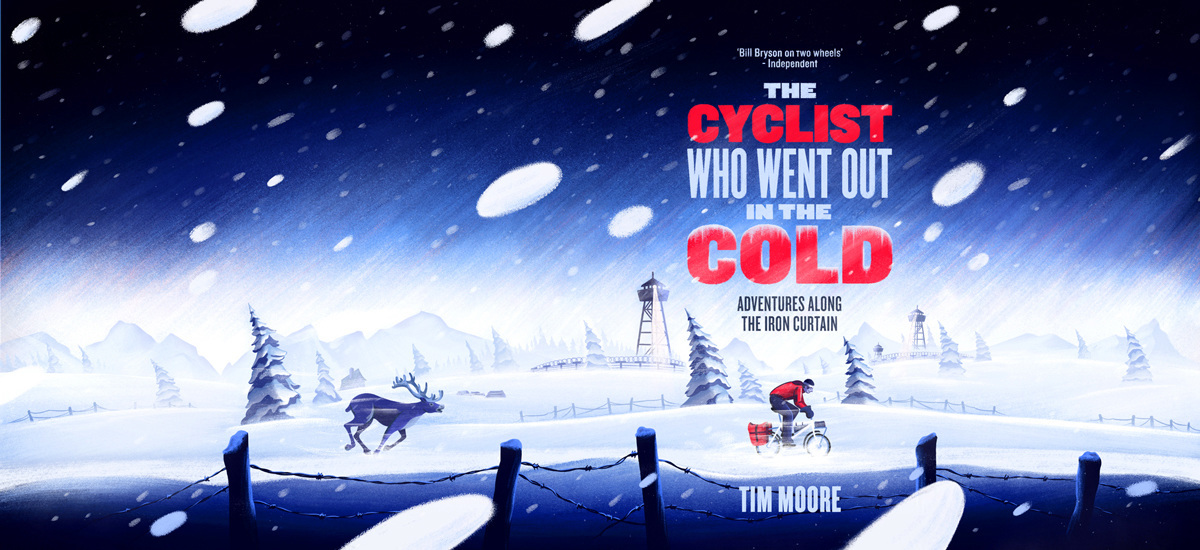Moore was born at the height of the Cold War, just after the Cuban missile crisis. He also was able to draw upon visits to the Soviet Union and Warsaw Pact countries in 1990, before the collapse of European communism, and peppers this travelogue liberally with reminiscences and comparisons with 2015.
Beyond the fact that his MIFA – mass-produced for the proletariat, as the only alternative to the unattainable automobile – would have been no serious cyclist's choice for such a journey, other considerations stun the reader. The average lifespan of a modern bike is 9,000 km, and the MIFA that Moore bought online was manufactured in 1990 needed a serious tune-up and customization. Two speeds and small wheels, an unreliable if not plain scary braking system, and the fact that the author did little physical training before setting off make the accomplishment that much more impressive.
Finland during an Arctic winter? Russia and the parts of Karelia once belonging to Finland were daunting. Thus the eleven pages that Moore devotes to Estonia are noteworthy as he escapes the glum Soviet legacies and is cheered by Estonia's roads and people. Moore writes that with regard to WW II “nowhere on earth had a worse war than Estonia.” He factures in not only war losses, occupation massacres, but also fleeing the Soviets and post-war deportations, coming up with a population loss of 25% for the nation.
With regard to the Baltic uprising that resulted in the collapse of the Soviet Union Moore calls Estonia the “iron-throated crucible of this very pro-democratic rebellion.” As we know, after the Warsaw Pact satellites began to “defect to democracy” the Soviet Union fiercely clung on to the Baltic States. The author's command of events is notable with regard to every country that he cycled through.
Alas, the only flaw in this captivating book is in the section on Estonia. In every other country – especially Finland, but Latvia and Lithuania as well – Moore faithfully observes local language practice, notably with diacritics, especially with place names. Näätämö in Finland. A sign showing distance to MOCKBA. Jūrmala in Latvia. Juodkrantė in Lithuania. Schönberg in Germany But he forgot about the umlauts in Estonia. We read about Kiek-in-de-Kok. No ö. A poster that screams MUUA KRUNT! No Ü. And a store called Puutookoda. Considering that Moore took the effort everywhere else this is a curious slip.
Moore dedicates a lot of attention to communism, the Vlads (Lenin and Putin), WWII, the Soviet system that encouraged informing on your neighbour. His dislike of the system then and now is obvious. Not a positive word anywhere. Nowhere is this more evident in the lengthy chapters on East Germany. All the satellite states, especially Romania, are flayed viciously in the author's rear-view mirror. Some did not fare well in the present, either. In many ways the author cycled at times through a modern-day hell.
All this is entertainingly written, self-depreciation is part of the approach, and results in what the Irish Times called a description of a “hilariously painful – and poignant – adventure.” The book's cover has the Independent likening Moore to Bill Bryson, a selling point, as Bryson is another talented author who combines travel and sly, dry, droll, often blatantly outrageous wit. And a bit of crudeness for the adolescent present in every man.
Hands down the funniest book that this reader has encountered in some time. Also without a doubt one of the most educational books, illuminating the crimes and cruelties of communism in Europe, and how, as the late (and last) Czechoslovakian president Václav Havel wrote, the legacies of communism will take at least two generations to be overcome. For that political slant alone Moore's book belongs on the bookshelf in the accurate observation category. The wit just makes it a much more delightful read.
Tõnu Naelapea, Toronto




